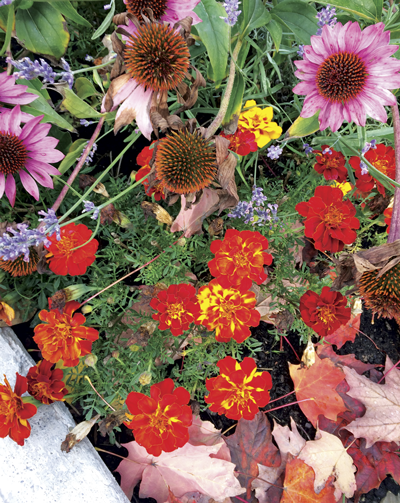February 26, 2015
Heirloom 'appyness
BY SEAN JAMESWe’re frequently bombarded with news about genetically modified organisms, and pushback from around the globe. Let’s weed that out for now, and focus on the brighter side of the story. Old varieties of seeds, often termed heirloom or heritage varieties, have a lot going for them beyond perceived ‘wholesomeness.’

‘French Red Brocade’ is an heirloom marigold with striking large red flowers and a long period of bloom. Here, the colour combines nicely with purple coneflower.
Brandywine tomato is my personal favourite, but it is UUUUUgly! Others are tiger striped, black/purple, golden yellow (yellow varieties usually have less acid and a milder taste) and the different types of cherry tomatoes seem endless. In many cases, flowering annuals will be much larger, since we have been breeding plants to fit smaller suburban gardens. This all makes for a larger plant palette. None of this is to say that modern hybrids and cultivars don’t have a place, since many are bred for disease resistance, form, colour and dwarf characteristics. However, one usually cannot save seed, since they will not maintain the same characteristics of the parent plant. New cultivars will be more inbred and selected for different features, so may have lost fragrance and complexity of flavour — but they too have a place in your toolbox.
Heirloom plants stand out for their reliable seed germination rate. Breeding techniques often reduce seed germination in following generations. Home gardeners and landscapers alike can save some of the seed from the previous year, dry it, always label it carefully, and keep it in a cool, dry place such as the fridge to sow for next season. Events known as seed exchanges or ‘Seedy Saturdays’ are held all over North America where folks can trade or buy varieties they don’t have.
Although, industrially, we only grow three main types of potatoes, there are hundreds of varieties that were originally developed in the Andes. Each was adapted to different elevations, rain and sunlight levels. Every cultivar has different tolerance to diseases, so if a disease sweeps through an area, some plants will be killed while others will thrive. This means, by growing a mixture of cultivars, you are not putting all your eggs in one basket. Diversity is key to a steady harvest. Some are finger shaped, some are bulky. Some are purple, while some are golden.

Reset your thinking, and try growing redroot pigweed, a delicious and attractive edible leaf vegetable that can easily be grown from seed.
Most annuals and vegetables have heirloom seed available. It’s worth a reminder that, as professionals, we fall victim to two syndromes; we forget we don’t know everything and we forget to have fun. The wonderful thing about what we do is that we’re always able to learn new things and we have a job that’s inherently enjoyable.
Blow a bit of money on new seed you don’t know. Fail! Succeed. Play. Broaden your skill set. We often bemoan horticulture’s dwindling market share, but we forget the fastest growing part of that market is edible landscaping. We lose touch with the fact that much of the world is moving toward sustainable horticulture. Be aware of these issues, and your business will stand out in the eyes of potential customers.
Sean James is owner of an Ontario-based environmentally-conscious landscape design/build/maintenance company, an eco-consultant and a popular speaker.